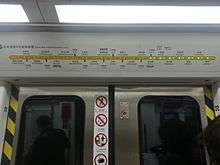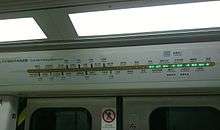Line 6 (Beijing Subway)
Line 6 of the Beijing Subway (Chinese: 北京地铁6号线; pinyin: běijīng dìtiě liùhào xiàn) is a rapid transit rail line in Beijing. The line runs from Jin'anqiao in Shijingshan District to Lucheng in Tongzhou District. It serves important residential areas such as Changying, Chaoqing, and Dingfuzhuang,[5] in addition to important commercial and business areas such as Financial Street, Beijing CBD and the sub-administrative center in Tongzhou District.[6][7][8] Like Line 7, Line 6 provides relief to the parallel Line 1, which is the second most used subway line in Beijing, after Line 10. Line 6 is the second longest subway line in Beijing (only Line 10 is longer). A complete journey from end to end takes about an hour and 25 minutes on a local train and express trains reducing end to end travel time by 7 minutes.[9]
| Line 6 | |||||||||||||||||||||||||||||||||||||||||||||||||||||||||||||||||||||||||||||||||||||||||||||||||||||||||||||||||||||||||||||||||||||||||||||||||||||||||||||||||||||||||||||||||||||||||||||||||||||||||||||||||||||||||||||||||||||||||||||||||||||||||||||||||||||||||||||||||||||||||||||||||||||||||||||||||||||||||||||||||||||||||||||||||||||||||||||||||||||||||||||||||||||||||||||||||||||||||||||||||||||||||||||||||||||||||||||||||||||||||||||||||||||||||||||||||||||||||||||||||||||||||||||||||||||||||||||||||||||||||||||||||||||||||||||||||||||||||||||||||||||||||||||
|---|---|---|---|---|---|---|---|---|---|---|---|---|---|---|---|---|---|---|---|---|---|---|---|---|---|---|---|---|---|---|---|---|---|---|---|---|---|---|---|---|---|---|---|---|---|---|---|---|---|---|---|---|---|---|---|---|---|---|---|---|---|---|---|---|---|---|---|---|---|---|---|---|---|---|---|---|---|---|---|---|---|---|---|---|---|---|---|---|---|---|---|---|---|---|---|---|---|---|---|---|---|---|---|---|---|---|---|---|---|---|---|---|---|---|---|---|---|---|---|---|---|---|---|---|---|---|---|---|---|---|---|---|---|---|---|---|---|---|---|---|---|---|---|---|---|---|---|---|---|---|---|---|---|---|---|---|---|---|---|---|---|---|---|---|---|---|---|---|---|---|---|---|---|---|---|---|---|---|---|---|---|---|---|---|---|---|---|---|---|---|---|---|---|---|---|---|---|---|---|---|---|---|---|---|---|---|---|---|---|---|---|---|---|---|---|---|---|---|---|---|---|---|---|---|---|---|---|---|---|---|---|---|---|---|---|---|---|---|---|---|---|---|---|---|---|---|---|---|---|---|---|---|---|---|---|---|---|---|---|---|---|---|---|---|---|---|---|---|---|---|---|---|---|---|---|---|---|---|---|---|---|---|---|---|---|---|---|---|---|---|---|---|---|---|---|---|---|---|---|---|---|---|---|---|---|---|---|---|---|---|---|---|---|---|---|---|---|---|---|---|---|---|---|---|---|---|---|---|---|---|---|---|---|---|---|---|---|---|---|---|---|---|---|---|---|---|---|---|---|---|---|---|---|---|---|---|---|---|---|---|---|---|---|---|---|---|---|---|---|---|---|---|---|---|---|---|---|---|---|---|---|---|---|---|---|---|---|---|---|---|---|---|---|---|---|---|---|---|---|---|---|---|---|---|---|---|---|---|---|---|---|---|---|---|---|---|---|---|---|---|---|---|---|---|---|---|---|---|---|---|---|---|---|---|---|---|---|---|---|---|---|---|---|---|---|---|---|---|---|---|---|---|---|---|---|---|---|---|---|---|---|---|---|---|---|---|---|---|---|---|---|---|---|---|---|---|---|---|---|---|---|---|---|---|---|---|---|---|---|---|---|---|---|---|---|---|---|---|---|---|---|---|---|---|---|---|---|---|---|---|---|---|---|---|---|---|---|---|---|---|---|---|---|---|---|---|---|---|---|---|---|---|---|---|---|---|---|---|---|---|---|---|---|---|---|---|---|---|---|---|---|---|---|---|---|---|---|---|---|---|---|---|---|---|---|---|---|---|---|---|---|---|---|
| 6 | |||||||||||||||||||||||||||||||||||||||||||||||||||||||||||||||||||||||||||||||||||||||||||||||||||||||||||||||||||||||||||||||||||||||||||||||||||||||||||||||||||||||||||||||||||||||||||||||||||||||||||||||||||||||||||||||||||||||||||||||||||||||||||||||||||||||||||||||||||||||||||||||||||||||||||||||||||||||||||||||||||||||||||||||||||||||||||||||||||||||||||||||||||||||||||||||||||||||||||||||||||||||||||||||||||||||||||||||||||||||||||||||||||||||||||||||||||||||||||||||||||||||||||||||||||||||||||||||||||||||||||||||||||||||||||||||||||||||||||||||||||||||||||||
| Overview | |||||||||||||||||||||||||||||||||||||||||||||||||||||||||||||||||||||||||||||||||||||||||||||||||||||||||||||||||||||||||||||||||||||||||||||||||||||||||||||||||||||||||||||||||||||||||||||||||||||||||||||||||||||||||||||||||||||||||||||||||||||||||||||||||||||||||||||||||||||||||||||||||||||||||||||||||||||||||||||||||||||||||||||||||||||||||||||||||||||||||||||||||||||||||||||||||||||||||||||||||||||||||||||||||||||||||||||||||||||||||||||||||||||||||||||||||||||||||||||||||||||||||||||||||||||||||||||||||||||||||||||||||||||||||||||||||||||||||||||||||||||||||||||
| Other name(s) | M6 (planned name) | ||||||||||||||||||||||||||||||||||||||||||||||||||||||||||||||||||||||||||||||||||||||||||||||||||||||||||||||||||||||||||||||||||||||||||||||||||||||||||||||||||||||||||||||||||||||||||||||||||||||||||||||||||||||||||||||||||||||||||||||||||||||||||||||||||||||||||||||||||||||||||||||||||||||||||||||||||||||||||||||||||||||||||||||||||||||||||||||||||||||||||||||||||||||||||||||||||||||||||||||||||||||||||||||||||||||||||||||||||||||||||||||||||||||||||||||||||||||||||||||||||||||||||||||||||||||||||||||||||||||||||||||||||||||||||||||||||||||||||||||||||||||||||||
| Type | Rapid transit | ||||||||||||||||||||||||||||||||||||||||||||||||||||||||||||||||||||||||||||||||||||||||||||||||||||||||||||||||||||||||||||||||||||||||||||||||||||||||||||||||||||||||||||||||||||||||||||||||||||||||||||||||||||||||||||||||||||||||||||||||||||||||||||||||||||||||||||||||||||||||||||||||||||||||||||||||||||||||||||||||||||||||||||||||||||||||||||||||||||||||||||||||||||||||||||||||||||||||||||||||||||||||||||||||||||||||||||||||||||||||||||||||||||||||||||||||||||||||||||||||||||||||||||||||||||||||||||||||||||||||||||||||||||||||||||||||||||||||||||||||||||||||||||
| System | Beijing Subway | ||||||||||||||||||||||||||||||||||||||||||||||||||||||||||||||||||||||||||||||||||||||||||||||||||||||||||||||||||||||||||||||||||||||||||||||||||||||||||||||||||||||||||||||||||||||||||||||||||||||||||||||||||||||||||||||||||||||||||||||||||||||||||||||||||||||||||||||||||||||||||||||||||||||||||||||||||||||||||||||||||||||||||||||||||||||||||||||||||||||||||||||||||||||||||||||||||||||||||||||||||||||||||||||||||||||||||||||||||||||||||||||||||||||||||||||||||||||||||||||||||||||||||||||||||||||||||||||||||||||||||||||||||||||||||||||||||||||||||||||||||||||||||||
| Locale | Tongzhou, Chaoyang, Dongcheng, Xicheng, Haidian and Shijingshan districts Beijing | ||||||||||||||||||||||||||||||||||||||||||||||||||||||||||||||||||||||||||||||||||||||||||||||||||||||||||||||||||||||||||||||||||||||||||||||||||||||||||||||||||||||||||||||||||||||||||||||||||||||||||||||||||||||||||||||||||||||||||||||||||||||||||||||||||||||||||||||||||||||||||||||||||||||||||||||||||||||||||||||||||||||||||||||||||||||||||||||||||||||||||||||||||||||||||||||||||||||||||||||||||||||||||||||||||||||||||||||||||||||||||||||||||||||||||||||||||||||||||||||||||||||||||||||||||||||||||||||||||||||||||||||||||||||||||||||||||||||||||||||||||||||||||||
| Termini | Jin'anqiao Lucheng | ||||||||||||||||||||||||||||||||||||||||||||||||||||||||||||||||||||||||||||||||||||||||||||||||||||||||||||||||||||||||||||||||||||||||||||||||||||||||||||||||||||||||||||||||||||||||||||||||||||||||||||||||||||||||||||||||||||||||||||||||||||||||||||||||||||||||||||||||||||||||||||||||||||||||||||||||||||||||||||||||||||||||||||||||||||||||||||||||||||||||||||||||||||||||||||||||||||||||||||||||||||||||||||||||||||||||||||||||||||||||||||||||||||||||||||||||||||||||||||||||||||||||||||||||||||||||||||||||||||||||||||||||||||||||||||||||||||||||||||||||||||||||||||
| Stations | 32 | ||||||||||||||||||||||||||||||||||||||||||||||||||||||||||||||||||||||||||||||||||||||||||||||||||||||||||||||||||||||||||||||||||||||||||||||||||||||||||||||||||||||||||||||||||||||||||||||||||||||||||||||||||||||||||||||||||||||||||||||||||||||||||||||||||||||||||||||||||||||||||||||||||||||||||||||||||||||||||||||||||||||||||||||||||||||||||||||||||||||||||||||||||||||||||||||||||||||||||||||||||||||||||||||||||||||||||||||||||||||||||||||||||||||||||||||||||||||||||||||||||||||||||||||||||||||||||||||||||||||||||||||||||||||||||||||||||||||||||||||||||||||||||||
| Daily ridership | 601,900 (2014 avg.)[1][2] 1.07 million (2018 peak)[3] | ||||||||||||||||||||||||||||||||||||||||||||||||||||||||||||||||||||||||||||||||||||||||||||||||||||||||||||||||||||||||||||||||||||||||||||||||||||||||||||||||||||||||||||||||||||||||||||||||||||||||||||||||||||||||||||||||||||||||||||||||||||||||||||||||||||||||||||||||||||||||||||||||||||||||||||||||||||||||||||||||||||||||||||||||||||||||||||||||||||||||||||||||||||||||||||||||||||||||||||||||||||||||||||||||||||||||||||||||||||||||||||||||||||||||||||||||||||||||||||||||||||||||||||||||||||||||||||||||||||||||||||||||||||||||||||||||||||||||||||||||||||||||||||
| Operation | |||||||||||||||||||||||||||||||||||||||||||||||||||||||||||||||||||||||||||||||||||||||||||||||||||||||||||||||||||||||||||||||||||||||||||||||||||||||||||||||||||||||||||||||||||||||||||||||||||||||||||||||||||||||||||||||||||||||||||||||||||||||||||||||||||||||||||||||||||||||||||||||||||||||||||||||||||||||||||||||||||||||||||||||||||||||||||||||||||||||||||||||||||||||||||||||||||||||||||||||||||||||||||||||||||||||||||||||||||||||||||||||||||||||||||||||||||||||||||||||||||||||||||||||||||||||||||||||||||||||||||||||||||||||||||||||||||||||||||||||||||||||||||||
| Opened | December 30, 2012 | ||||||||||||||||||||||||||||||||||||||||||||||||||||||||||||||||||||||||||||||||||||||||||||||||||||||||||||||||||||||||||||||||||||||||||||||||||||||||||||||||||||||||||||||||||||||||||||||||||||||||||||||||||||||||||||||||||||||||||||||||||||||||||||||||||||||||||||||||||||||||||||||||||||||||||||||||||||||||||||||||||||||||||||||||||||||||||||||||||||||||||||||||||||||||||||||||||||||||||||||||||||||||||||||||||||||||||||||||||||||||||||||||||||||||||||||||||||||||||||||||||||||||||||||||||||||||||||||||||||||||||||||||||||||||||||||||||||||||||||||||||||||||||||
| Operator(s) | Beijing Mass Transit Railway Operation Corp., Ltd | ||||||||||||||||||||||||||||||||||||||||||||||||||||||||||||||||||||||||||||||||||||||||||||||||||||||||||||||||||||||||||||||||||||||||||||||||||||||||||||||||||||||||||||||||||||||||||||||||||||||||||||||||||||||||||||||||||||||||||||||||||||||||||||||||||||||||||||||||||||||||||||||||||||||||||||||||||||||||||||||||||||||||||||||||||||||||||||||||||||||||||||||||||||||||||||||||||||||||||||||||||||||||||||||||||||||||||||||||||||||||||||||||||||||||||||||||||||||||||||||||||||||||||||||||||||||||||||||||||||||||||||||||||||||||||||||||||||||||||||||||||||||||||||
| Character | Underground | ||||||||||||||||||||||||||||||||||||||||||||||||||||||||||||||||||||||||||||||||||||||||||||||||||||||||||||||||||||||||||||||||||||||||||||||||||||||||||||||||||||||||||||||||||||||||||||||||||||||||||||||||||||||||||||||||||||||||||||||||||||||||||||||||||||||||||||||||||||||||||||||||||||||||||||||||||||||||||||||||||||||||||||||||||||||||||||||||||||||||||||||||||||||||||||||||||||||||||||||||||||||||||||||||||||||||||||||||||||||||||||||||||||||||||||||||||||||||||||||||||||||||||||||||||||||||||||||||||||||||||||||||||||||||||||||||||||||||||||||||||||||||||||
| Rolling stock | 8-car Type B (DKZ47) | ||||||||||||||||||||||||||||||||||||||||||||||||||||||||||||||||||||||||||||||||||||||||||||||||||||||||||||||||||||||||||||||||||||||||||||||||||||||||||||||||||||||||||||||||||||||||||||||||||||||||||||||||||||||||||||||||||||||||||||||||||||||||||||||||||||||||||||||||||||||||||||||||||||||||||||||||||||||||||||||||||||||||||||||||||||||||||||||||||||||||||||||||||||||||||||||||||||||||||||||||||||||||||||||||||||||||||||||||||||||||||||||||||||||||||||||||||||||||||||||||||||||||||||||||||||||||||||||||||||||||||||||||||||||||||||||||||||||||||||||||||||||||||||
| Technical | |||||||||||||||||||||||||||||||||||||||||||||||||||||||||||||||||||||||||||||||||||||||||||||||||||||||||||||||||||||||||||||||||||||||||||||||||||||||||||||||||||||||||||||||||||||||||||||||||||||||||||||||||||||||||||||||||||||||||||||||||||||||||||||||||||||||||||||||||||||||||||||||||||||||||||||||||||||||||||||||||||||||||||||||||||||||||||||||||||||||||||||||||||||||||||||||||||||||||||||||||||||||||||||||||||||||||||||||||||||||||||||||||||||||||||||||||||||||||||||||||||||||||||||||||||||||||||||||||||||||||||||||||||||||||||||||||||||||||||||||||||||||||||||
| Line length | 53.4 km (33.2 mi)[4] | ||||||||||||||||||||||||||||||||||||||||||||||||||||||||||||||||||||||||||||||||||||||||||||||||||||||||||||||||||||||||||||||||||||||||||||||||||||||||||||||||||||||||||||||||||||||||||||||||||||||||||||||||||||||||||||||||||||||||||||||||||||||||||||||||||||||||||||||||||||||||||||||||||||||||||||||||||||||||||||||||||||||||||||||||||||||||||||||||||||||||||||||||||||||||||||||||||||||||||||||||||||||||||||||||||||||||||||||||||||||||||||||||||||||||||||||||||||||||||||||||||||||||||||||||||||||||||||||||||||||||||||||||||||||||||||||||||||||||||||||||||||||||||||
| Track gauge | 1,435 mm (4 ft 8 1⁄2 in) standard gauge | ||||||||||||||||||||||||||||||||||||||||||||||||||||||||||||||||||||||||||||||||||||||||||||||||||||||||||||||||||||||||||||||||||||||||||||||||||||||||||||||||||||||||||||||||||||||||||||||||||||||||||||||||||||||||||||||||||||||||||||||||||||||||||||||||||||||||||||||||||||||||||||||||||||||||||||||||||||||||||||||||||||||||||||||||||||||||||||||||||||||||||||||||||||||||||||||||||||||||||||||||||||||||||||||||||||||||||||||||||||||||||||||||||||||||||||||||||||||||||||||||||||||||||||||||||||||||||||||||||||||||||||||||||||||||||||||||||||||||||||||||||||||||||||
| Electrification | 1500 V Overhead line | ||||||||||||||||||||||||||||||||||||||||||||||||||||||||||||||||||||||||||||||||||||||||||||||||||||||||||||||||||||||||||||||||||||||||||||||||||||||||||||||||||||||||||||||||||||||||||||||||||||||||||||||||||||||||||||||||||||||||||||||||||||||||||||||||||||||||||||||||||||||||||||||||||||||||||||||||||||||||||||||||||||||||||||||||||||||||||||||||||||||||||||||||||||||||||||||||||||||||||||||||||||||||||||||||||||||||||||||||||||||||||||||||||||||||||||||||||||||||||||||||||||||||||||||||||||||||||||||||||||||||||||||||||||||||||||||||||||||||||||||||||||||||||||
| Operating speed | 100 km/h (62 mph) | ||||||||||||||||||||||||||||||||||||||||||||||||||||||||||||||||||||||||||||||||||||||||||||||||||||||||||||||||||||||||||||||||||||||||||||||||||||||||||||||||||||||||||||||||||||||||||||||||||||||||||||||||||||||||||||||||||||||||||||||||||||||||||||||||||||||||||||||||||||||||||||||||||||||||||||||||||||||||||||||||||||||||||||||||||||||||||||||||||||||||||||||||||||||||||||||||||||||||||||||||||||||||||||||||||||||||||||||||||||||||||||||||||||||||||||||||||||||||||||||||||||||||||||||||||||||||||||||||||||||||||||||||||||||||||||||||||||||||||||||||||||||||||||
| |||||||||||||||||||||||||||||||||||||||||||||||||||||||||||||||||||||||||||||||||||||||||||||||||||||||||||||||||||||||||||||||||||||||||||||||||||||||||||||||||||||||||||||||||||||||||||||||||||||||||||||||||||||||||||||||||||||||||||||||||||||||||||||||||||||||||||||||||||||||||||||||||||||||||||||||||||||||||||||||||||||||||||||||||||||||||||||||||||||||||||||||||||||||||||||||||||||||||||||||||||||||||||||||||||||||||||||||||||||||||||||||||||||||||||||||||||||||||||||||||||||||||||||||||||||||||||||||||||||||||||||||||||||||||||||||||||||||||||||||||||||||||||||
Line 6 uses 8-car size B train sets accommodating 1,960 people.[10] The trains are capable of reaching the speed of 100 km/h (62 mph). Stations to the east of the 3rd Ring Road to Tongzhou are more widely spaced, the furthest being 4 km (2.5 mi) apart. Line 6 also has the deepest station in the network, Dongsi station, which is 34 meters underground.[11] The line uses 1500 V overhead catenary as opposed to 750 V third rail used on other lines.[12] Some of the station arrangements were the first of their kind in Beijing. Beijing's first split platform station, Nanluoguxiang station, and stations equipped with passing tracks, opened on Line 6.[6]
Planning
Line 6 was originally planned to be an east–west line passing under Chaoyang Avenue continuing straight westward. However, this alignment would make the central section of Line 6 tunnel extremely close to the Forbidden City. Issues of historic conservation and protection were raised against the proposed alignment. To avoid damaging cultural relics in the area, the entire western and middle section of line 6 was shifted 1.5 km (0.93 mi) northward to Ping'an Avenue, forming the route of Line 6 today.[16][17] Line 6 started construction on December 8, 2007 as one of the "horizontal" east-west lines of the "three-ring, four horizontal and five vertical and seven radial" Beijing Subway masterplan.[18] Construction is planned in three phases, the first phase in central Beijing, followed by extensions into the eastern and western suburbs.
Line 6 was projected to have a short term volume of 700,000 passengers per day and a long term daily passenger traffic of 1.4 million passengers. Though due to its alignment through some of Beijing's densest residential neighborhoods and paralleling the overcapacity and busy Line 1, some industry leaders believed that the average daily passenger flow of the line may reach 1.4 million passengers per day sooner than expected.[12] Within the first few months of operation, weekday ridership was at 320,000 passengers. However, by 2014, daily ridership had risen to 700,000 with sections operating at 100% capacity during rush hour. Authorities responded by adding more trains and shortening headway to reduce crowding on the line.[2]
Phase I

In Phase I, Line 6 runs 30 km (19 mi) from Haidian Wuluju in Haidian District to Caofang in Chaoyang District following Linglong Road, Sanlihe Road, Chaoyang North Road, the west bank of the Grand Canal, and Yunhe East Road. In Phase I, there were 20 stations except the reserved Erligou station. Construction began in December 2007 and was completed in 2012. Total investment for Phase I was estimated at ¥19.7 billion.[13]
Line 6 in Phase I was originally slated to have elevated tracks for 7 km (4.3 mi), east of the 5th Ring Road, from Dingfuzhuang and Changying. After residents along the route raised concerns about train noise, planners reconsidered and ultimately decided to keep all of Phase I underground.[19][20][21] This made the first phase of Line 6 completely underground.[22]
Phase II (eastern extension)

In Phase II, which opened in 2014, Line 6 was extended further east by about 12 km (7.5 mi) through seven stations from Caofang to Lucheng in Tongzhou New Town. Like Phase I, the Phase II track is entirely underground.
The extension was designed to have express and local services using passing tracks at select stations.[23] However, due to a shortage of rolling stock, express services have yet to be implemented when the Phase II opens in 2014. In 2018, the government announced that sufficient rolling stock had arrived to begin implementing an express service.[24][25] Express services started operating on March 31, 2020.[9]
Phase III (western extension)
Line 6 was originally planned to terminate at Cishousi Station with the S1 Line continuing the line westward. In 2011, because of issues of low capacity and electromagnetic radiation concerns of Maglev technology, city planning authorities proposed to detach several stations from the S1 line. This would extend Line 6 10.556-km west with six stations from Jin'anqiao to Haidian Wuluju (the western terminus of Phase I).[26][27][28] All stations are below ground.[29] This replaced the S1 Line section between Cishousi and Pingguoyuan station.[30] Later the plan was revised with Line 6 being further extended westward beyond Pingguoyuan to Jin'anqiao station, paralleling the S1 Line.[29] The revision was formalized and submitted to the National Development and Reform Commission for review in March 2012.[29]
History
- As of October 2007, Line 6 was planned to feature both express and local stations, but those plans have not been incorporated into the construction of Phase I.[31]
- On March 22, 2010, the tunneling work on Line 6 commenced near Shilipu in Chaoyang District.[32]
- As of November 2010, plans for Phase II contained distinct express and local stations.[33]
- On December 30, 2012, the Phase I stations opened, except for Erligou.
- On December 28, 2014, the Phase II stations opened, except for Tongyunmen and Beiyunhe East.
- On December 30, 2018, the Phase III stations, except for Pingguoyuan, were opened. An infill station on Phase II, Beiyunhe East station, was also opened.
| Segment | Commencement | Length | Station(s) | Name |
|---|---|---|---|---|
| Haidian Wuluju — Caofang | 30 December 2012 | 29.882 km (18.57 mi) | 20 | Phase 1 |
| Caofang — Lucheng | 28 December 2014 | 12.751 km (7.92 mi) | 6 | Phase 2 |
| Beiyunhe East | 30 December 2018 | infill station | 1 | |
| Jin'anqiao — Haidian Wuluju | 10.556 km (6.56 mi)[28] | 5 | Phase 3 |
Rolling Stock
| Model | Image | Manufacturer | Year Built | Amount in Service | Fleet Numbers | Depot |
|---|---|---|---|---|---|---|
| DKZ47 |  |
CRRC Changchun Railway Vehicles | 2011 | 84 | 06 001–06 084 | Wulu Wuliqiao Dongxiaoying |
References
- 客流信息. Beijing Subway. Retrieved 2015-03-20.
- "Archived copy" 晚高峰加小圈车 地铁6号线满载率降12%. 首都之窗. 2014-08-22. Archived from the original on 2015-01-05. Retrieved 2014-09-14.CS1 maint: archived copy as title (link)
- "北京轨道交通日客运量首破1300万人次". 中国新闻社. 2018-07-14. Retrieved 2018-07-14.
- http://www.xinhuanet.com/local/2018-12/28/c_1123916410.htm
- 6号线助力朝北新盘崛起. 2012-11-30. Archived from the original on 2015-05-09. Retrieved 2012-12-29.
- 轨道交通6号线预计年底试运营 五项第一彰显北京地铁新奇迹. Beijing Municipal Transportation Committee (北京市交通委员会). 2012-09-26. Archived from the original on 2012-11-11. Retrieved 2012-09-26.
- 北京地铁6号线西延通过专家评审 全长52公里共33站. 2012-11-14. Archived from the original on 2013-01-12. Retrieved 2012-12-29.
- Wen Ru (温薷); Wang Jianing (王嘉宁) (2013-03-15). 地铁六号线二期拟增至8站点. Retrieved 2013-03-16.
- "四条地铁线开行大站快车". bjwb.bjd.com.cn. Retrieved 2020-04-24.
- "Archived copy" 4条地铁线将装屏蔽门. 法制晚报. 2010-01-20. Archived from the original on 2011-07-21. Retrieved 2012-08-24.CS1 maint: archived copy as title (link)
- <New Beijing subway to ease traffic congestion, Wu Wenjie, deputy director of China Railway Tunnel Group, China Daily. Reporter ZHENG Xin. 2012-11-26.
- "Archived copy" 四条地铁新线12月28日同步开通(图). 163.com. 2012-08-31. Archived from the original on 2016-03-04. Retrieved 2012-09-06.CS1 maint: archived copy as title (link)
- (Chinese) Beijing Infrastructure Investment Co., Ltd. Line 6 Plan, BII Accessed on September 6, 2008
- "6号线 | 北京地铁官方网站". www.bjsubway.com. Retrieved 2020-04-24.
- "6号线路网车站站间距信息". Retrieved 2020-04-29.
- Archived copy 《超级工程》第三集《北京地铁网络》. China Central Television. Event occurs at 07:20. Archived from the original on 2013-01-01. Retrieved 2012-12-29.CS1 maint: archived copy as title (link)
- 2012年九月份科普论坛报告会. Archived from the original on 2014-09-13. Retrieved 2012-12-29.
- 北京5条新地铁12月8日同时开工建设. 2007-12-08. Retrieved 2012-12-29.
- 北京地铁6号线可能噪音扰民 有望改走地下 ->(行业动态)->行业动态->筑龙网
- 北京市规划委员会关于北京地铁6号线高架线的复函 - 房产 - 青传媒 Archived 2011-07-07 at the Wayback Machine
- "北京市规划委回复人民热线:地铁6号线一期工程均为地下线" 人民网 October 13, 2008
- "Archived copy" 轨道交通6号线一期工程规划方案公告. 北京市规划委员会. 2010-01-14. Archived from the original on 2010-12-27. Retrieved 2012-12-29.CS1 maint: archived copy as title (link)
- http://society.people.com.cn/n/2013/1113/c1008-23531866.html
- 北京地铁6号线将为副中心跑“大站快车”. bj.people.com.cn. 2018-03-02.
- chinanews. 北京地铁6号线西延拟年底通车 或将“大站跑快车”-中新网. www.chinanews.com. Retrieved 2018-03-04.
- (in Chinese)北京地铁6号线西延段放弃采用磁悬浮形式 July 2, 2011
- (Chinese)"地铁6号线将西延至杨庄东街" 2012-03-23
- "两条地铁线路年内将"升级"". 2018-10-18.
- "Archived copy" 北京地铁6号线西延工程变更公示. 中国铁道科学研究院. 2013-11-21. Archived from the original on 2013-12-21. Retrieved 2013-11-21.CS1 maint: archived copy as title (link)
- "Archived copy" 8号线3期6号线西延将开工 2015年总里程666公里. 2011-04-27. Archived from the original on 2011-12-14. Retrieved 2012-12-29.CS1 maint: archived copy as title (link)
- "Archived copy" 北京地铁6号线方案获批复 将尝试大站快车(图)_TOM新闻 (in Chinese). 2007-10-30. Archived from the original on 2007-11-02. Retrieved 2008-07-05.CS1 maint: archived copy as title (link)
- 6号线一期开始“挖地道”. 163.com news (in Chinese). 2010-03-23.
- (Chinese) 2010-11-18
External links
